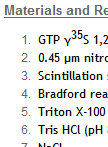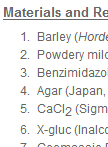Improve Research Reproducibility A Bio-protocol resource
- Protocols
- Articles and Issues
- About
- Become a Reviewer
Past Issue in 2013
Volume: 3, Issue: 9
Biochemistry
In vitro Lipid Binding Assay
This is a protocol to examine in vitro protein-lipid binding using membrane strips coated with various lipids. It has been successfully used to study in vitro interaction between lipids and C. elegans proteins.
In vitro Lipid Transfer Assay
This is a protocol to detect lipid transfer activity of NRF-5, a member of the LPS binding/lipid transfer protein family. The lipid transfer activity is examined by using isotope-labeled cholesterol and liposomes, and tested in two directions (Figure 1): from proteins to liposomes and from liposomes to proteins.
GTP Binding Assays in Arabidopsis thaliana
Signaling through G proteins constitutes an ancient mechanism that functions in the transduction of extracellular signals into intracellular responses. Activation of a proper receptor by a stimuli leads to an exchange of GDP for GTP, the activation of G proteins and the dissociation of Gα-GTP from the Gβγ dimer for the heterotrimeric G proteins. The G protein subunits remain active until the intrinsic GTPase activity or/and a GTPase activating protein result in the hydrolysis of GTP to GDP and the inactivation of the protein. Here we describe a protocol for measuring GTP binding activity from Arabidopsis plant protein extracts using GTP γ35S. GTP γ35S assay measures the level of G protein activation following a stimuli, by determining the binding activity of the non-hydrolysable analog GTP γ35S. To determine specific G protein activities specific mutants and/or overexpressors extracts should be included and measured as controls.
Cancer Biology
Subcellular Fractionation of Cultured Human Cell Lines
Subcellular localization is crucial for the proper functioning of a protein. Deregulation of subcellular localization may lead to pathological consequences and result in diseases like cancer. Immuno-fluorescent staining and subcellular fractionation can be used to determine localization of a protein. Here we discuss a protocol to separate the nuclear, cytosolic, and membrane fractions of cultured human cell lines using a centrifuge and ultracentrifuge. The membrane fraction contains plasma membranes and ER-golgi membranes, but no mitochondria or nuclear structures. The fractions can be further analyzed using Western blotting. This protocol is based on that from Dr. Richard Patten at Abcam, and was modified and utilized in a publication by Huang et al. (2012).
Developmental Biology
Quantification of Cell Corpses, Cell Death Occurrence, Cell Corpse Duration
During the development of the C. elegans hermaphrodite, 131 of the 1090 somatic cells generated undergo programmed cell death, among which 113 die during embryogenesis starting from 200-cell stage. The apoptotic cells (also called “cell corpses”) appear as highly refractile button-like objects and are easily identified using differential interference contrast (DIC) optics (Robertson et al., 1982).
Immunology
Cell Isolation of Spleen Mononuclear Cells
This method allows you to isolate different subclass mononuclear cells, like B-cells, T cells, CD4+ and CD8+ T, from mouse spleen. By conjugating cells with specific antibodies and subsequently magnetic beads isolation, using the technique from Miltenyi, this allows a high purity.
Plant Science
Measuring Stomatal Density in Rice
The number of stomata on leaves is known to be affected by various environmental factors and intrinsic developmental program. Stomatal density and stomatal index are generally used as indicators of the leaf development and the plant growth. This protocol describes an easy, non-destructive method for preparing imprints of the rice leaf surface that is suitable for observation and counting of stomata. Researchers can process many leaf samples at once in the field or in the green house distance from the laboratory.
Modified Single-Cell Transient Gene Expression Assay in Barley Epidermal Cells
Transient gene expression via biolistic particle delivery is a widely used technique for gene functional analysis in plants. In this protocol we describe a modified single-cell transient expression assay through transformation with a particle inflow gun of the model PDS-1000/He system (Bio-Rad). This assay was originally optimized for analyzing cell death activity and disease resistance function of the barley MLA (mildew locus A) disease resistance proteins against the powdery mildew fungus, which can be further adopted for other purposes for other types of plant proteins and in some other plant species, including Arabidopsis thaliana.
Stem Cell
Single-cell Gene Expression Profiling of Mouse Stem Cells With Fluidigm BiomarkTM Dynamic Array
This protocol describes how to use Fluidigm BiomarkTM 96.96 dynamic arrays for high-throughput expression profiling from single mouse stem cells, assaying up to 96 independent samples with up to 96 quantitative PCR (qPCR) probes (equivalent to 9,216 reactions) in a single experiment. This Dynamic Array contains a network of microfluidic channels, chambers and valves that automatically assemble all these individual PCR reactions. Single-cell profiling can provide definitive evidence of stem cell heterogeneity. Modifications are most likely needed if users intend to use BiomarkTM 48.48 Dynamic array or experimenter-designed primers in conjunction with DNA-binding dyes such as EvaGreen (Biotium 31000).













